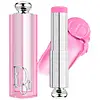What's inside
What's inside
 Key Ingredients
Key Ingredients

 Benefits
Benefits

 Concerns
Concerns

 Ingredients Side-by-side
Ingredients Side-by-side

Water
Skin ConditioningC9-12 Alkane
SolventSynthetic Fluorphlogopite
Dicaprylyl Ether
EmollientCoco-Caprylate/Caprate
EmollientPropanediol
SolventPolyglyceryl-6 Polyricinoleate
EmulsifyingDisteardimonium Hectorite
StabilisingPolyglyceryl-2 Isostearate
EmulsifyingLecithin
EmollientEuphorbia Cerifera Cera
AstringentGlycerin
HumectantPentylene Glycol
Skin ConditioningPolyglyceryl-10 Decaisostearate
EmollientHibiscus Sabdariffa Flower Extract
Skin ConditioningIris Florentina Root Extract
MaskingMica
Cosmetic ColorantSodium Chloride
MaskingSodium Myristoyl Glutamate
CleansingHydroxyacetophenone
AntioxidantEthylhexylglycerin
Skin ConditioningEthylene Brassylate
MaskingPotassium Sorbate
PreservativePropylene Carbonate
SolventSilica
AbrasiveParfum
MaskingAluminum Hydroxide
EmollientTin Oxide
AbrasiveTocopherol
AntioxidantHydrolyzed Viola Tricolor Extract
Skin ProtectingCaprylic/Capric Triglyceride
MaskingPolyhydroxystearic Acid
Emulsifying1,2-Hexanediol
Skin ConditioningCaprylyl Glycol
EmollientCitric Acid
BufferingIsostearic Acid
CleansingPolyglyceryl-3 Polyricinoleate
EmulsifyingSodium Benzoate
MaskingTitanium Dioxide
Cosmetic ColorantCI 77163
Cosmetic ColorantCI 77491
Cosmetic ColorantWater, C9-12 Alkane, Synthetic Fluorphlogopite, Dicaprylyl Ether, Coco-Caprylate/Caprate, Propanediol, Polyglyceryl-6 Polyricinoleate, Disteardimonium Hectorite, Polyglyceryl-2 Isostearate, Lecithin, Euphorbia Cerifera Cera, Glycerin, Pentylene Glycol, Polyglyceryl-10 Decaisostearate, Hibiscus Sabdariffa Flower Extract, Iris Florentina Root Extract, Mica, Sodium Chloride, Sodium Myristoyl Glutamate, Hydroxyacetophenone, Ethylhexylglycerin, Ethylene Brassylate, Potassium Sorbate, Propylene Carbonate, Silica, Parfum, Aluminum Hydroxide, Tin Oxide, Tocopherol, Hydrolyzed Viola Tricolor Extract, Caprylic/Capric Triglyceride, Polyhydroxystearic Acid, 1,2-Hexanediol, Caprylyl Glycol, Citric Acid, Isostearic Acid, Polyglyceryl-3 Polyricinoleate, Sodium Benzoate, Titanium Dioxide, CI 77163, CI 77491
Polyglyceryl-2 Triisostearate
EmulsifyingSqualane
EmollientHydrogenated Polydecene
EmollientDimer Dilinoleyl Dimer Dilinoleate
EmollientHelianthus Annuus Seed Wax
Skin ConditioningMica
Cosmetic ColorantCera Alba
EmollientTrimethylolpropane Triisostearate
EmollientCopernicia Cerifera Wax
Diisostearyl Malate
EmollientParfum
MaskingEthyl Vanillin
MaskingPrunus Avium Seed Oil
EmollientPentaerythrityl Tetra-Di-T-Butyl Hydroxyhydrocinnamate
AntioxidantMenthol
MaskingVanillin
MaskingAluminum Hydroxide
EmollientMentha Piperita Oil
MaskingPropyl Gallate
AntioxidantCI 77891
Cosmetic ColorantCI 45410
Cosmetic ColorantCI 15850
Cosmetic ColorantPolyglyceryl-2 Triisostearate, Squalane, Hydrogenated Polydecene, Dimer Dilinoleyl Dimer Dilinoleate, Helianthus Annuus Seed Wax, Mica, Cera Alba, Trimethylolpropane Triisostearate, Copernicia Cerifera Wax, Diisostearyl Malate, Parfum, Ethyl Vanillin, Prunus Avium Seed Oil, Pentaerythrityl Tetra-Di-T-Butyl Hydroxyhydrocinnamate, Menthol, Vanillin, Aluminum Hydroxide, Mentha Piperita Oil, Propyl Gallate, CI 77891, CI 45410, CI 15850
Ingredients Explained
These ingredients are found in both products.
Ingredients higher up in an ingredient list are typically present in a larger amount.
Aluminum Hydroxide is a form of aluminum. It can be naturally found in nature as the mineral gibbsite. In cosmetics, Aluminum Hydroxide is used as a colorant, pH adjuster, and absorbent.
As a colorant, Aluminum Hydroxide may add opacity, or reduce the transparency. Aluminum hydroxide is contains both basic and acidic properties.
According to manufacturers, this ingredient is an emollient and humectant. This means it helps hydrate the skin.
In medicine, this ingredient is used to help relieve heartburn and help heal ulcers.
There is currently no credible scientific evidence linking aluminum hydroxide in cosmetics to increased cancer risk.
Major health organizations allow the use of aluminum hydroxide in personal care products and have not flagged it as a carcinogenic risk at typical usage levels.
Learn more about Aluminum HydroxideMica is a naturally occurring mineral used to add shimmer and color in cosmetics. It can also help improve the texture of a product or give it an opaque, white/silver color.
Serecite is the name for very fine but ragged grains of mica.
This ingredient is often coated with metal oxides like titanium dioxide. Trace amounts of heavy metals may be found in mica, but these metals are not harmful in our personal products.
Mica has been used since prehistoric times throughout the world. Ancient Egyptian, Indian, Greek, Roman, Aztec, and Chinese civilizations have used mica.
Learn more about MicaParfum is a catch-all term for an ingredient or more that is used to give a scent to products.
Also called "fragrance", this ingredient can be a blend of hundreds of chemicals or plant oils. This means every product with "fragrance" or "parfum" in the ingredients list is a different mixture.
For instance, Habanolide is a proprietary trade name for a specific aroma chemical. When used as a fragrance ingredient in cosmetics, most aroma chemicals fall under the broad labeling category of “FRAGRANCE” or “PARFUM” according to EU and US regulations.
The term 'parfum' or 'fragrance' is not regulated in many countries. In many cases, it is up to the brand to define this term.
For instance, many brands choose to label themselves as "fragrance-free" because they are not using synthetic fragrances. However, their products may still contain ingredients such as essential oils that are considered a fragrance by INCI standards.
One example is Calendula flower extract. Calendula is an essential oil that still imparts a scent or 'fragrance'.
Depending on the blend, the ingredients in the mixture can cause allergies and sensitivities on the skin. Some ingredients that are known EU allergens include linalool and citronellol.
Parfum can also be used to mask or cover an unpleasant scent.
The bottom line is: not all fragrances/parfum/ingredients are created equally. If you are worried about fragrances, we recommend taking a closer look at an ingredient. And of course, we always recommend speaking with a professional.
Learn more about Parfum